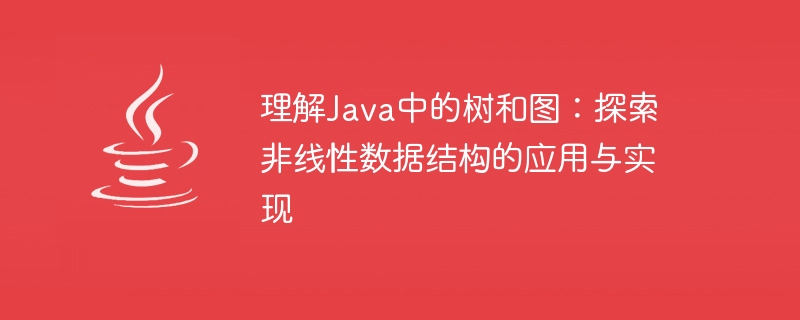ホームページ >Java >&#&チュートリアル >Java におけるツリーとグラフの非線形データ構造のアプリケーションと実装方法の詳細な調査
Java におけるツリーとグラフの非線形データ構造のアプリケーションと実装方法の詳細な調査
- 王林オリジナル
- 2023-12-26 10:22:091068ブラウズ

Java のツリーとグラフを理解する: 非線形データ構造のアプリケーションと実装を探索する
-
はじめに コンピューター サイエンスでは、データ構造が重要な役割を果たします。データはコンピュータに保存、整理、および管理されます。データ構造は、線形データ構造と非線形データ構造に分類できます。ツリーとグラフは、最も一般的に使用される 2 つのタイプの非線形データ構造です。この記事では、Java におけるツリーとグラフの概念、アプリケーション、実装に焦点を当て、具体的なコード例を示します。 -
ツリーの概念と応用 ツリーは抽象データ型であり、ノードとエッジの集合です。ツリーの各ノードには、データ要素と他のノードへのポインタが含まれています。ツリーの特別なノードはルート ノードと呼ばれ、親ノードはありません。他のすべてのノードには親ノードと 0 個以上の子ノードがあります。ツリーの重要な用途は、検索と分類です。たとえば、二分探索ツリーは、O(log n) の時間計算量で要素の検索、挿入、削除を行うことができる、一般的に使用されるツリー構造です。以下は、バイナリ検索ツリーの簡単な Java 実装例です。
class Node {
int data;
Node left;
Node right;
public Node(int item) {
data = item;
left = right = null;
}
}
class BinarySearchTree {
Node root;
public BinarySearchTree() {
root = null;
}
public void insert(int data) {
root = insertRec(root, data);
}
private Node insertRec(Node root, int data) {
if (root == null) {
root = new Node(data);
return root;
}
if (data < root.data)
root.left = insertRec(root.left, data);
else if (data > root.data)
root.right = insertRec(root.right, data);
return root;
}
public boolean search(int data) {
return searchRec(root, data);
}
private boolean searchRec(Node root, int data) {
if (root == null)
return false;
if (data == root.data)
return true;
if (data < root.data)
return searchRec(root.left, data);
return searchRec(root.right, data);
}
}
public class Main {
public static void main(String[] args) {
BinarySearchTree bst = new BinarySearchTree();
bst.insert(50);
bst.insert(30);
bst.insert(70);
bst.insert(20);
bst.insert(40);
bst.insert(60);
bst.insert(80);
System.out.println("Is 20 present? " + bst.search(20));
System.out.println("Is 100 present? " + bst.search(100));
}
}上の例では、バイナリ ツリーのノードを表す Node クラスと、そのノードを表す BinarySearchTree クラスを定義します。二分探索ツリー。 insert メソッドを使用して要素をツリーに挿入し、search メソッドを使用して要素を検索できます。 -
グラフの概念と応用 グラフはノードとエッジの集合であり、ノードはグラフ内の要素を表し、エッジはノード間の接続関係を表します。グラフの重要な用途は、ネットワークと関係を表現することです。たとえば、ソーシャル ネットワークでは、ユーザーをノードとして表現し、ユーザー間のフォロー関係や友人関係をエッジとして表現できます。以下は、グラフの簡単な Java 実装例です。
import java.util.*;
class Graph {
private int V;
private LinkedList<Integer>[] adjList;
public Graph(int v) {
V = v;
adjList = new LinkedList[v];
for (int i = 0; i < v; ++i)
adjList[i] = new LinkedList();
}
void addEdge(int v, int w) {
adjList[v].add(w);
}
void BFS(int s) {
boolean[] visited = new boolean[V];
LinkedList<Integer> queue = new LinkedList<Integer>();
visited[s] = true;
queue.add(s);
while (queue.size() != 0) {
s = queue.poll();
System.out.print(s + " ");
Iterator<Integer> i = adjList[s].listIterator();
while (i.hasNext()) {
int n = i.next();
if (!visited[n]) {
visited[n] = true;
queue.add(n);
}
}
}
}
}
public class Main {
public static void main(String args[]) {
Graph g = new Graph(4);
g.addEdge(0, 1);
g.addEdge(0, 2);
g.addEdge(1, 2);
g.addEdge(2, 0);
g.addEdge(2, 3);
g.addEdge(3, 3);
System.out.println("BFS traversal starting from vertex 2:");
g.BFS(2);
}
}上の例では、隣接リンク リストを使用してグラフのデータ構造を表しています。 Graph クラスを定義します。このクラスでは、addEdge メソッドを使用してエッジを追加し、BFS メソッドを使用して幅優先検索トラバーサルを実行します。この例では、頂点 2 から開始して BFS 走査を実行し、走査順序を出力します。 -
結論 この記事では、Java のツリーとグラフの概念、アプリケーション、実装方法を紹介し、具体的なコード例を示します。ツリーとグラフは一般的に使用されるタイプの非線形データ構造であり、コンピューター サイエンスで幅広い用途に使用されます。ツリーとグラフの基本概念と実装方法を習得することで、非線形データ構造をよりよく理解して処理し、それらを適用して実際的な問題を解決できるようになります。
以上がJava におけるツリーとグラフの非線形データ構造のアプリケーションと実装方法の詳細な調査の詳細内容です。詳細については、PHP 中国語 Web サイトの他の関連記事を参照してください。
声明:
この記事の内容はネチズンが自主的に寄稿したものであり、著作権は原著者に帰属します。このサイトは、それに相当する法的責任を負いません。盗作または侵害の疑いのあるコンテンツを見つけた場合は、admin@php.cn までご連絡ください。

